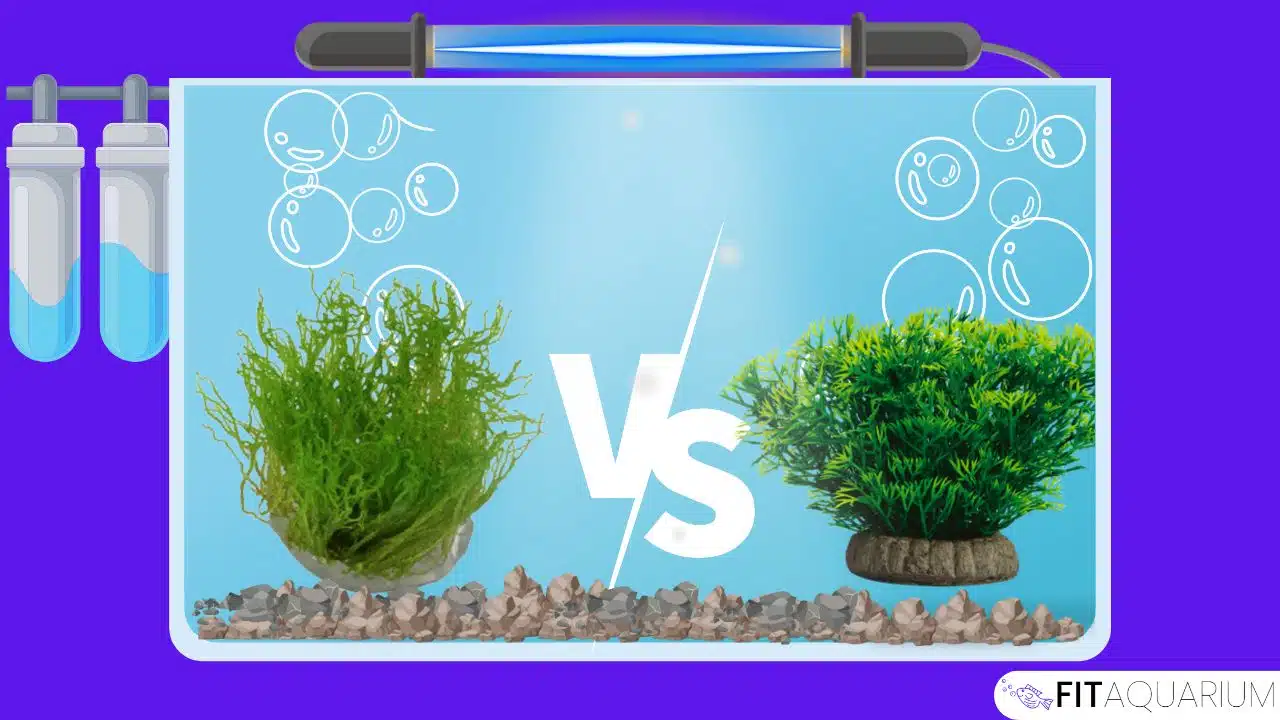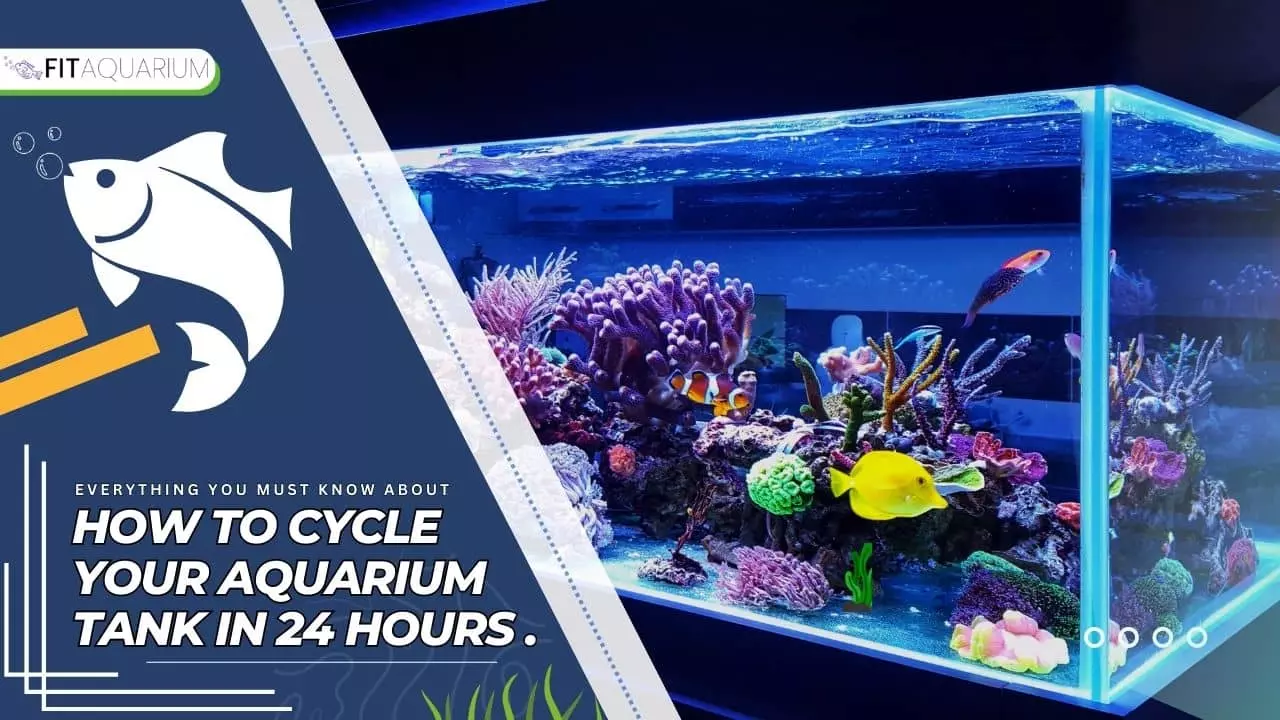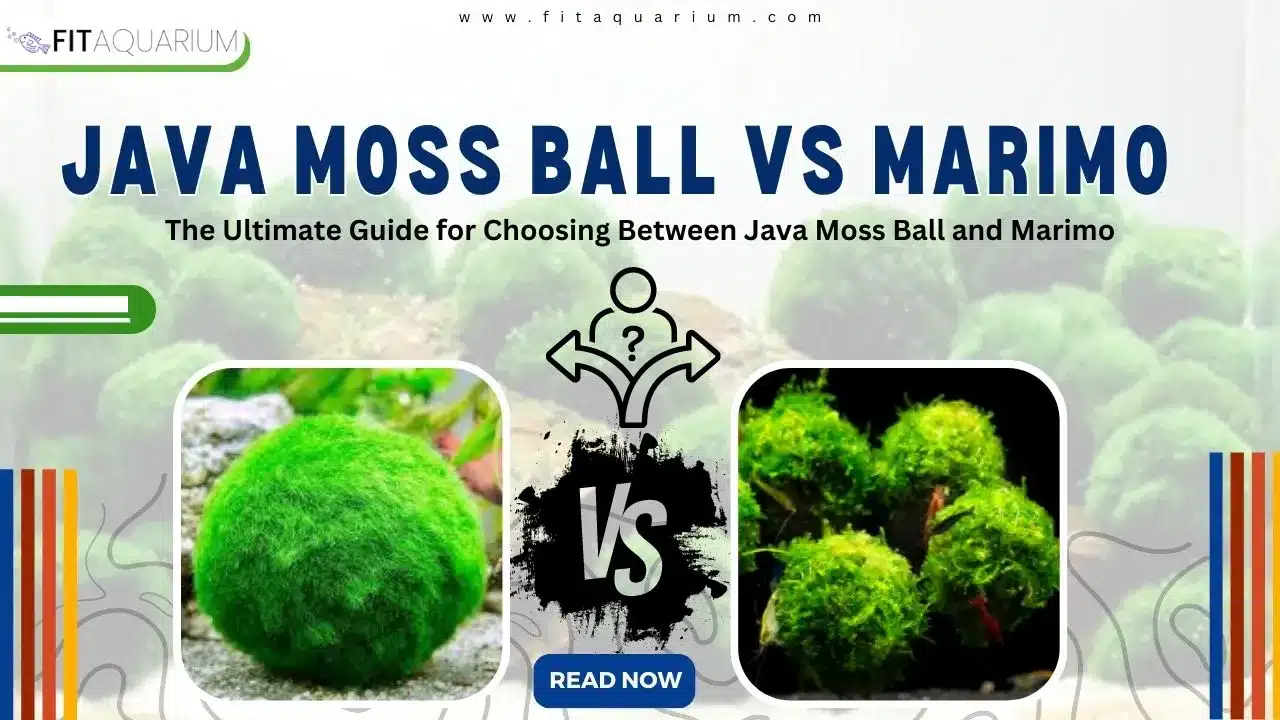In the world of aquatic wonders, two attractive creatures stand out: the mudpuppy and the axolotl. Join us on a journey of discovery as we dive into the distinct and interesting characteristics that will help you to choose wisely between one of them for your fish aquarium. These mystical beings are renowned for their unique features, enchanting appearances, and curious behaviors.
Mudpuppies and axolotls are often mistaken for one another due to their similar marine lifestyles, conduct & interaction in aquariums and external gill structures. These two species, however, have specific traits and uncommon characteristics that distinguish them, making each a marvel in its own right and different species from different families.
Table of Contents
Overview
Mudpuppies and axolotls are both members of the salamander family, a group of amphibians recognized for their extraordinary ability to survive in both water and on land. However, unlike their terrestrial relatives, both salamanders prefer to remain underwater throughout their lives, evoking a sense of eternal peace and flexibility.
Mudpuppies’ amazing looks, with their slim bodies, velvety skin decorated with striking dark spots, and expressive eyes, appear to hold countless tales. Axolotl, on the other hand, fascinates with their otherworldly appearance, which includes delicately fringed gills along with satisfying external gill stalks and a lovable smile that never departs from their attractive faces.
Origins and Natural Habitat of Mudpuppy vs Axolotl
Both the “Mudpuppy” and the “Axolotl” are amphibians from the order Caudata (or Urodela), which also contains salamanders and newts. As far as these two have some similarities, their origins, and natural environments are quite different. So let’s dive into the detailed information about these two species:
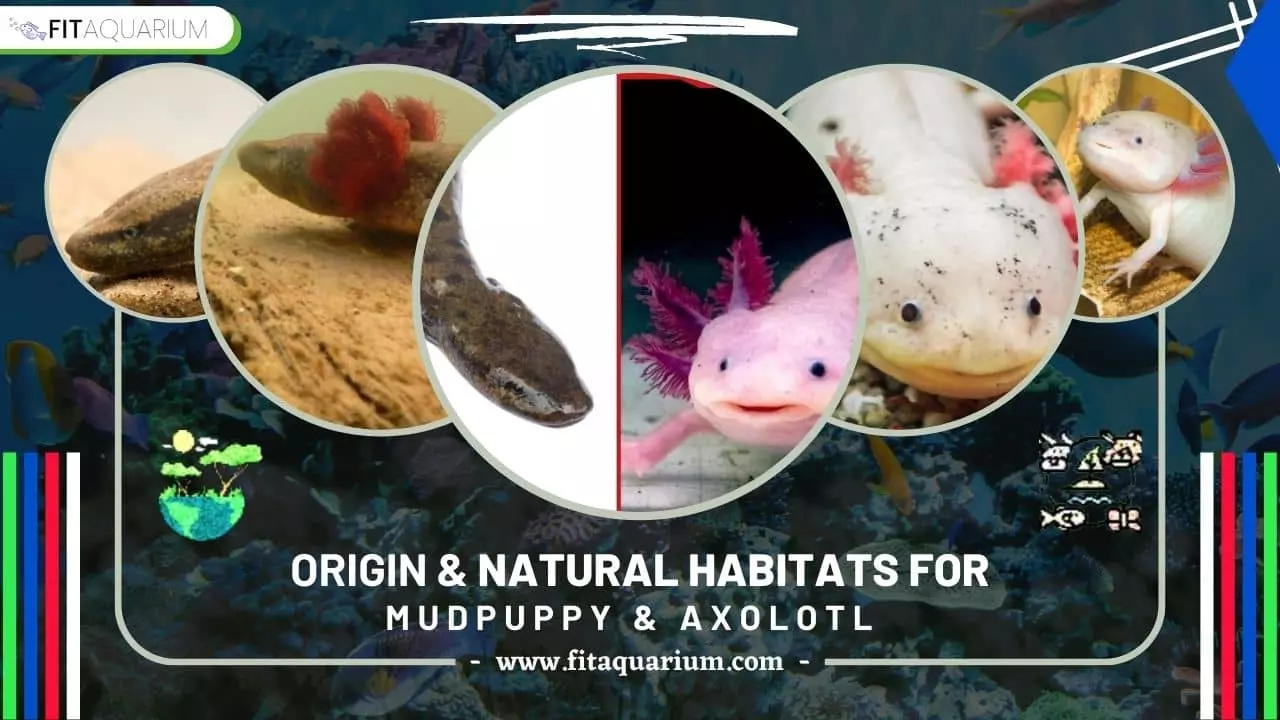
Origin
Mudpuppies are native to North America, particularly the eastern and central parts of the continent. They are found in a variety of freshwater settings, such as lakes, rivers, and streams.
Axolotls are native to South America (Mexico). primarily in the Lake Xochimilco and Chalco neighborhoods of Mexico City. They are a critically endangered species in the wild frequently raised in captivity for study and as pets.
Natural Habitat of Mudpuppy vs Axolotl
Mudpuppies prefer seawater habitats with plenty of vegetation, rocky surfaces, and hiding spots. They are commonly found in slow-moving or stationary bodies of water, such as ponds and marshes. Mudpuppies have external gills that allow them to breathe underwater throughout their lives, unlike most other salamanders that undergo metamorphosis and lose their gills. Mudpuppies live both underwater and above the water.
Axolotls are neotenic, which means they attain sexual maturity without undergoing metamorphosis. They live in high-altitude freshwater lakes and canals, most particularly the Xochimilco Lake system. Axolotls prefer environments with dense vegetation mud, and plenty of hiding spots. Axolotls, unlike mudpuppies, have their gills throughout their lives and thus axolotls are aquatic.
Mudpuppies are distributed throughout North America and inhabit a variety of freshwater environments whereas axolotls are restricted to specific regions of Mexico and live in high-altitude freshwater lakes and canals. Mudpuppies are better adapted to slow-moving or stagnant waters, whereas axolotls are neotenic, which means they keep their gills throughout their life, allowing them to remain fully aquatic in entire life.
Physical Characteristics and Appearance Mudpuppy and Axolotl
Here are the different characteristics and physical appearances that are possessed by these salamanders.

Size, Shape and Body of Mudpuppy and Axolotl
One of the best ways to tell the difference between a mudpuppy and an axolotl is their shape and body.
Mudpuppies are actually salamanders of medium size which can grow from 8 to 13 inches (20 to 33 cm) in length. They own a strong body with short, stocky limbs and a large, vertically flattened tail that helps them while swimming. They have four well developed limbs with grasping claws. Their limbs are relatively short and strong, adapted for navigating underwater environments.
Axolotls are also salamanders, but compared to mudpuppies, axolotls are relatively small commonly in size. However, it’s important to note that individual size can vary within each species, and there can be larger or smaller individuals within their respective size ranges.
Axolotls usually have sizes from 6 to 18 inches (15 to 45 cm) in length. But on average, mudpuppies tend to be larger than axolotls. They have a long, slender body featuring four short, sensitive limbs and a long, flattened finned tail for efficient swimming in water. Axolotls have four limbs as well, but their limbs are more delicate than mudpuppies. Their claws are less prominent and their digits are thin.
Color & Texture
Mudpuppies have dark spots which scatter all over their body. As far as skin color is concerned, mudpuppies have dark brown or grayish-brown skin. They have a patchy or stripped texture that helps them camouflage with the rocks and aquatic vegetation in their habitat.
Axolotls have a variety of colors including shades of brown, gray, olive, and albino forms. They also have different varieties in patterns like spots, speckles, or even leucistic (white with pinkish hue) forms. Axolotls have smooth skin, however, some of them may have tiny external gill stalks on their heads in symmetry.
Head and Gills
Head and gills are also an easy way to tell the difference between an axolotl and a mudpuppy.
Mudpuppy own small eyes over a broad head with a wide mouth. The most notable thing in mudpuppies that makes them different from other species is that they have external gills. These gills appear as bushy red feathery structures on the sides of their heads. This thing allows them to survive underwater throughout their life cycles.
Axolotls have small eyes over triangular-shaped heads and wide mouths. They have gills on the sides of their heads, similar to mudpuppies. The gills are fluffy and can vary in color, usually ranging from red to pinkish.
Both of these species have distinct features and characteristics that contribute to their adaptations for an aquatic lifestyle.
Lifecycle and Development of Axolotls and Mudpuppies
Here’s an overview of their lifecycle and development which will allow you to understand the lifespans of both of these species.
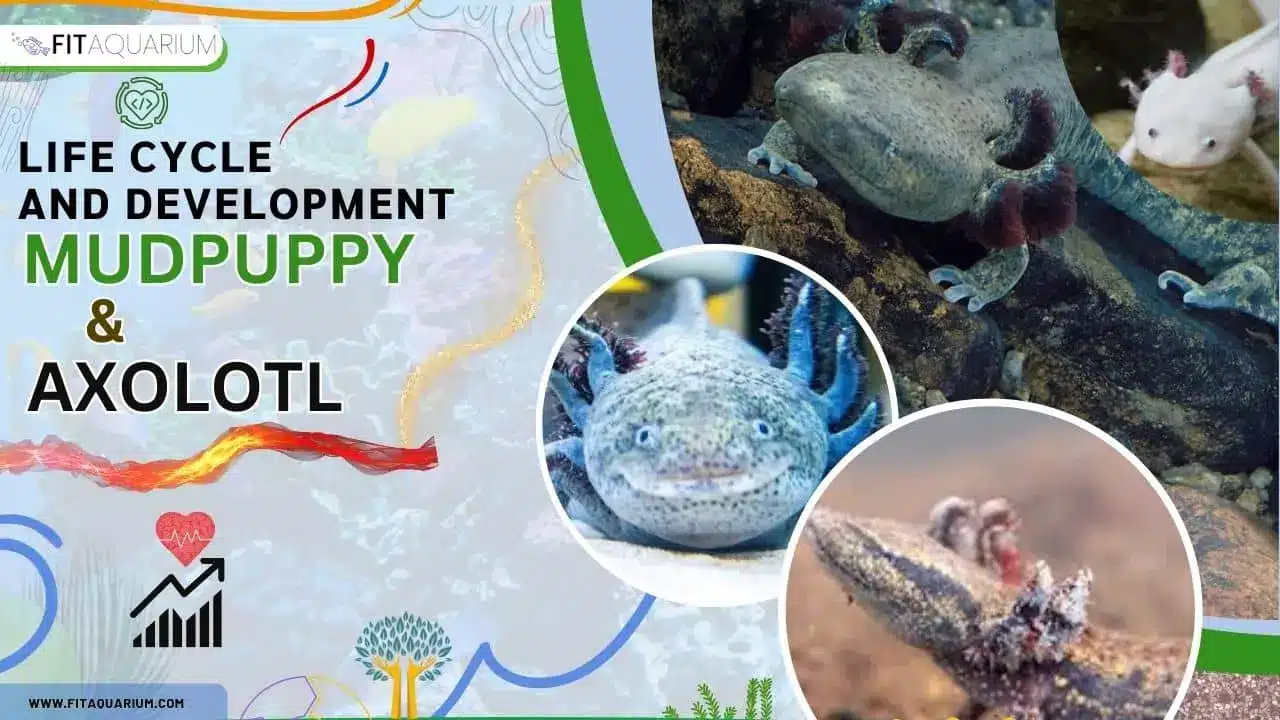
- Egg Stage of Axolotl and a Mudpuppy
Mudpuppies breed sexually, with the female laying eggs in submerged cavities or attached to plants. The eggs are laid in clusters and are usually gelatinous.
Axolotls breed sexually as well, with the female laying eggs in aquatic habitats. These eggs are often seen attached to submerged plants.
- Larval State
After incubation, the eggs hatch into aquatic larvae known as “Neotenes.”. The larvae come up with gills on their skin that allow them to breathe through their skin underwater easily. These larvae are completely aquatic, with a long tail and moderately large gills.
The axolotl eggs hatch into larvae after a time of brooding. Axolotl larvae look like small adults and have clearly visible gills.
Axolotls, unlike mudpuppies, go through neoteny, which means they attain sexual maturity without going through a stage of metamorphosis. As a result, the larvae retain their larval features throughout their lives.
- Juvenile Stage
The stage of metamorphosis occurs in mudpuppies when the larvae grow. The gills become less visible in this phase, and their limbs develop and become stronger. This transformation from larvae to juveniles takes place gradually over time.
Unlike Mudpuppies, There is no juvenile stage in axolotls.
- Adult Stage of Axolotls vs Mudpuppies
The mudpuppies attain the adult form as soon as their metamorphosis is completed. Adult ones are completely aquatic and retain their external gills throughout their lives. They have all those capabilities that are required for reproduction so they reproduce to continue the lifecycle.
Axolotls reach sexual maturity without losing their larval characteristics. They have reproductive capabilities in their larval form and do not typically undergo a full transformation into adult terrestrial salamanders. Both species retain their juvenile features as adults.
It’s important to note that in their natural habitats, both of these species may have variations in their development and lifecycle depending on various factors such as environmental conditions, individual characteristics, and exposure to food availability. But here the thing is that mudpuppies metamorphose from larvae to juveniles with gills, whereas axolotls retain larval traits, including gills, throughout their lives without going through complete metamorphosis.
Mudpuppies can live up to 20 years while axolotls have an average lifespan of 10 to 15 years.
Feeding Habits and Dietary Preferences
As mudpuppies and axolotls are both aquatic amphibians, have similar feeding preferences. However, they have different dietary habits. I am providing an overview of their eating habits and nutritional preferences.
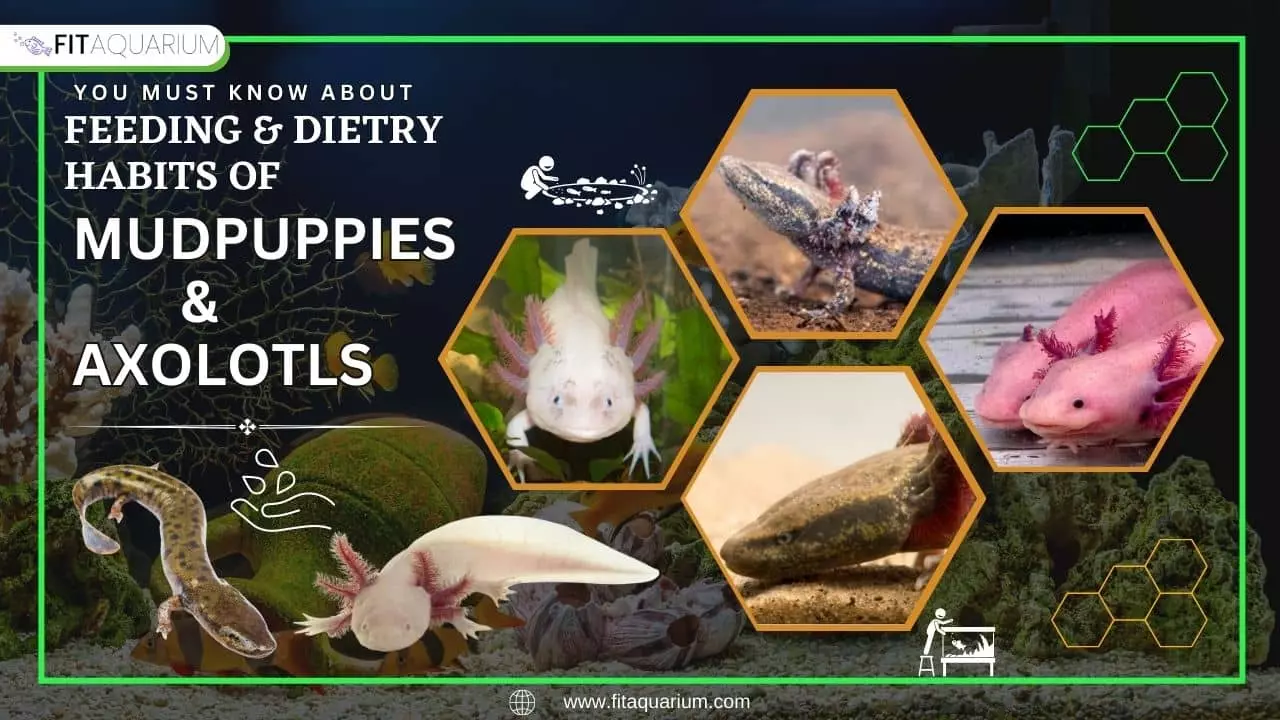
Mudpuppy Feeding Habits and Dietary Preferences:
- Mudpuppies, also known as Necturus salamanders, have a diverse diet.
- They commonly feed on mollusks, worms, insects, and small fish.
- It has been observed that mudpuppies are occasionally caught by fishermen, particularly during ice fishing. This suggests that they may also be active in colder temperatures when food sources like insects are less available.
- They have a good sense of smell. This helps them find their prey in their aquatic habitat.
- Mudpuppies often hunt in the nights so they are referred to as nocturnal. They use their strong jaws to capture and tear apart their prey for consumption.
Axolotl Feeding Habits and Dietary Preferences:
- Same as Mudpuppies, Axolotls are meat-eating amphibians too.
- They are mostly scavengers and predators, however, their diet can vary as per their size and availability of prey within their environment. But in most cases, axolotls feed on small aquatic prey such as insects, crustaceans, small fish, amphibian larvae, etc. along with some aquatic worms, mollusks, and other small invertebrates.
- Axolotls have a god-gifted mechanism of suction feeding that helps them to suck quickly over their prey by producing a vacuum with their mouth just like leeches.
- Their hunger is voracious as they will start feeding whenever possible over whatever they capture as their prey.
- In the wild, they eat a similar diet to mudpuppies but are less likely to be caught by fishermen.
It’s very important to note that both mudpuppies and axolotls are versatile feeders that may change their diet depending on the availability of prey in their different habitats. In captivity, you can supplement their diet with commercially available food items specifically designed for aquatic salamanders. Providing a variety of diet that replicates their natural prey is important for their overall health and growth.
Environmental Requirements and Tank Setup for Mudppupy & Axolotl
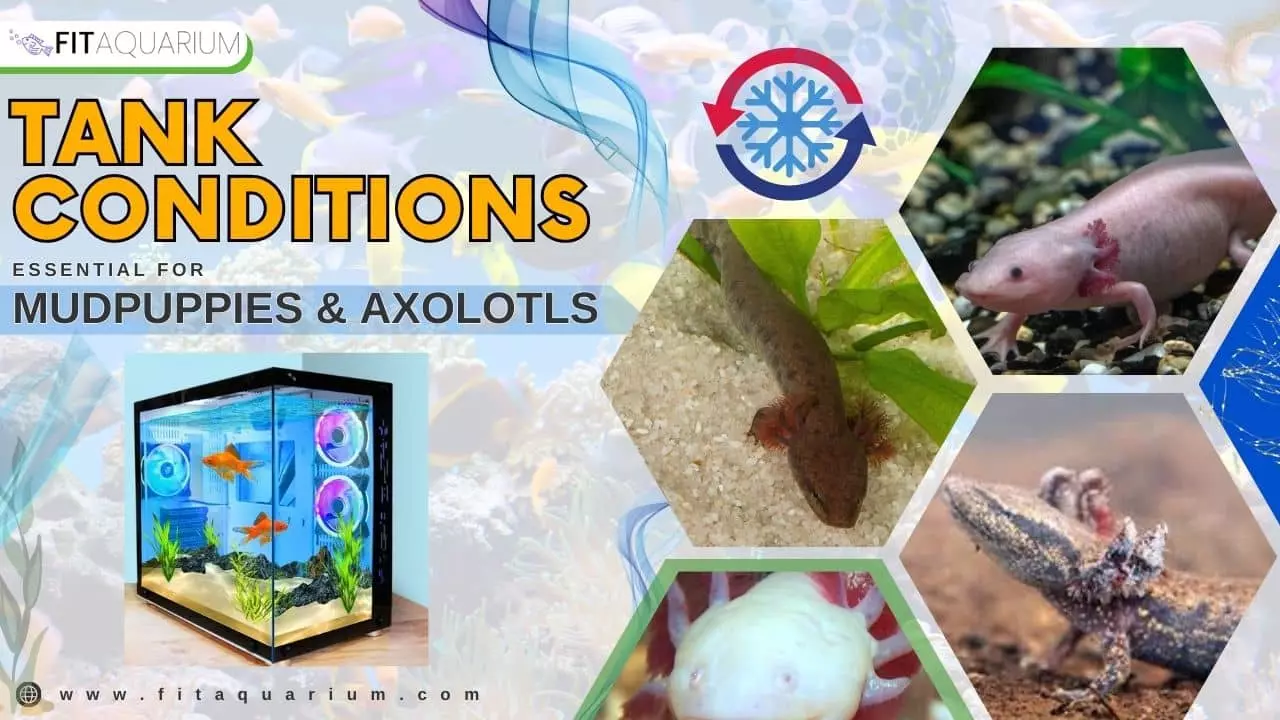
Axolotls and mudpuppies are both aquatic amphibians that require specific environmental conditions and tank setups to survive. Here are some tips to create appropriate habitats for both of these two species.
- Tank Size and Setup:
Mudpuppies require a tank with a minimum size of 20 gallons with additional space for each additional mudpuppy. The tank must be secured by a lid to prevent escapes.
Axolotls require a larger tank size compared to mudpuppies. A 20-gallon tank is suitable for a young axolotl, but you must have to provide a tank of the size of 40 gallons or more to accommodate their larger size.
- Water Parameters:
Temperature: Both species prefer a relatively cool environment. For mudpuppies, you can keep the water temperature between 60-72°F (15-22°C). While for axolotls, temperatures between 60-68°F (15-20°C) is recommended.
pH Level: Try to maintain a neutral pH level of around 7.0 for both mudpuppies and axolotls.
Water Quality: Water must be cleaned. Provide de-chlorinated water to both species. Regular water changes are necessary to maintain good quality water. Like mudpuppies, axolotls also need clean water.
Lighting: Mudpuppies and axolotls are not excessively dependent on UV lights. However, you can provide a low-intensity light source that can help to establish a day-night cycle and can enhance the tank’s aesthetics.
Remember to constantly monitor water parameters, make water changes as needed, and keep the environment clean and healthy for both species. I also recommend you do research and consult care guides for more detailed information about the environmental needs of these biotic creatures.
Behavior and Temperament of Axolotl vs Mudpuppy
Both Mudpuppy and Axolotl show distinct behaviors and temperaments. Here’s an overview of their typical behavior and temperament:
Mudpuppy Behavior and Temperament:
Semi-Aquatic Lifestyle:
As mudpuppies are entirely aquatic amphibians, they may travel onto land occasionally, especially under rainy conditions. However, They are not as terrestrial as some other amphibians, and therefore mudpuppies are commonly found underwater
Shy & Timid:
Mudpuppy a shy creature and hides when someone gets near them. They are not aggressive towards humans in general, but it is preferred to avoid direct contact with them Always observe them from a safe distance if you are new to the aquascaping hobby. But on a comparison note, they are more aggressive than axolotls
Skilled Swimmers:
Mudpuppies are skilled swimmers, moving through the water with agility with their long, flattened tails and sturdy limbs. They can climb over barriers in their aquatic surroundings.
Solitary Nature:
Mudpuppies are solitary loving creatures who prefer to live alone rather than in groups. They are not hostile towards fellows, but if you keep them together in captivity, they may compete for resources.
Nocturnal Activity:
Mudpuppies are usually nocturnal, which means they are more active at night. They tend to hide during the day and become more active and search for food at night.
Axolotl Behavior and Temperament:
Gentle & Calm:
Axolotls are recognized for their kind, calm and gentle nature. They are normally non-aggressive and can be handled with ease. However, they must be handled with care to avoid injury or damage to their delicate skin.
Bottom-Dwelling Behavior:
Axolotls are mostly bottom dwellers, spending most of their time resting or exploring the substrate at the bottom of their aquariums. They occasionally come to the surface to breathe, but mostly they prefer to stay near the bottom.
Curious and Interactive:
Axolotls often show curiosity and interact with their environment. They like to investigate the objects, plants, and decorations in their tank. Some axolotls become habitual of their owners and recognize them during feeding time.
Regenerative Abilities:
Axolotls got their fame through their extraordinary regenerative abilities. They can easily regenerate lost limbs, their spinal cord, and even sections of their heart and brain too. Because of their extraordinary regenerating abilities, they have become a subject of scientific interest.
Interactions with Humans: Keeping as Pets
Both of these two salamanders can be kept and sold as pets. Mudpuppies and axolotls are different in appearance and behaviors that are amazing to observe. While they are not typically handled as frequently as other pets, so some individuals might tolerate gentle handling. It is necessary to provide them with a proper tank setup, maintain water quality, and supply nutritious feed. Interacting with these amphibians should be done with care in order to avoid causing stress or harm to the creatures.
Choosing one from Mudpuppy vs Axolotl
Ultimately, the decision to choose between a mudpuppy and an axolotl depends on personal preferences, availability, and the ability to meet their specific care needs. By comparing these two using the information provided in this article, you can come up with what you want and what you can provide. Researching both species will help you make an informed decision about which amphibian would be the best to fit as a pet in your aquarium.
Frequently Asked Questions
Here are some frequently asked questions.
-
what is the difference between a mudpuppy and an axolotl?
The primary difference is their natural habitat and life stages. Mudpuppies are usually found in North America’s freshwater habitat, while axolotls are found in Mexico’s Xochimilko Lake (South America). Both are completely Aquatic. Unlike mudpuppies, axolotls don’t have a Juvenile stage in their lifecycle.
-
Are mudpuppies rare?
According to the International Union for Conservation of Nature (ICUN), the common mudpuppy is rated as “least concern”. The species is widespread, with an estimated population of more than 10,000 adult individuals. However, not all is well for the common mudpuppy, since some local populations are declining.
-
Can you keep a mudpuppy as a pet?
Yes, you can keep Mudpuppy as a pet, but before you make that decision, conduct research on the following points.
I. Legality: Check with your local wildlife agency or your country’s pet regulations to see if keeping a mudpuppy as a pet is legal.
II. Can you provide the appropriate habitat?
III. Can you feed them well?
If everything on this checklist checks out, you’re good to go.


